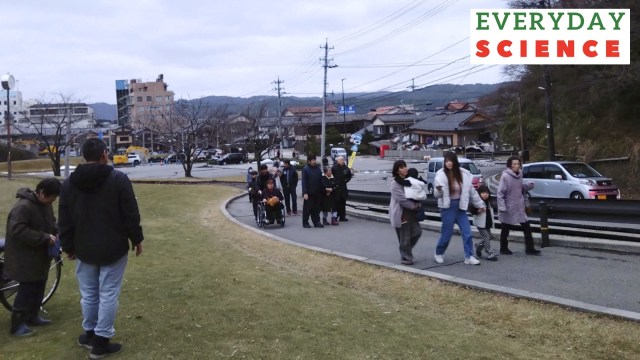- India
- International
Japan earthquake triggers tsunami warning: What is a tsunami, why does it keep forming in the island country?
Tsunami is a Japanese word that means “harbour wave”. It is generally caused by earthquakes or volcanic eruptions under the ocean. Here is everything you need to know about tsunamis.
 People evacuate toward higher ground after a tsunami warning caused by an earthquake in Wajima, Ishikawa prefecture, Japan January 1, 2024, in this image released by Kyodo. Mandatory credit Kyodo via REUTERS
People evacuate toward higher ground after a tsunami warning caused by an earthquake in Wajima, Ishikawa prefecture, Japan January 1, 2024, in this image released by Kyodo. Mandatory credit Kyodo via REUTERS Tsunami waves hit several parts of Japan’s coastal areas and urgent evacuation warnings were issued after a 7.6-magnitude earthquake shook the country’s north-central region on Monday (January 1).
Japanese Prime Minister Fumio Kishida, in a televised address, asked citizens to follow evacuation orders closely and warned that more powerful quakes and tsunami waves might follow the initial ones.
What is a tsunami?
Tsunami (a Japanese word that means “harbour wave”) is a series of giant ocean waves caused by earthquakes or volcanic eruptions under the ocean. When an earthquake takes place under the ocean, a large chunk of the ocean floor can suddenly move upward or downward, leading to a sudden displacement of a large volume of water, thereby causing tsunami waves.
A similar thing can happen when a volcano erupts in the ocean. The lava flowing out of the volcano displaces the water around it and that water can become a large wave.
“Big tsunamis usually begin in the deep ocean, where a large volume of water can be displaced. As the wave moves closer to the shore, it grows taller as the ocean becomes shallower,” according to a report by NASA.

Tsunami waves can be hundreds of feet tall and can travel as fast as jet planes over deep waters while slowing down when reaching shallow waters.
However, not all earthquakes or volcanic eruptions lead to tsunamis. The formation of a tsunami can depend on a host of factors, including the shape of the ocean floor, and the earthquake’s distance and direction.
Why is Japan prone to earthquakes and tsunamis?
That’s because of its location. Japan is situated along the ‘Pacific Ring of Fire’, which is the most active earthquake tectonic belt in the world. The ‘ring’ refers to “an imaginary horseshoe-shaped zone that follows the rim of the Pacific Ocean, where many of the world’s earthquakes and volcanic eruptions occur,” according to a report by Live Science.
Within the Ring of Fire, there are different tectonic belts, including the Pacific Plate, Eurasian Plate, and Indo-Australian Plate, which keep meshing and colliding with each other, causing earthquakes, volcanic eruptions and tsunamis.
In 2011, Japan was hit by a 9.0 magnitude earthquake and a resulting tsunami which devastated its northeastern coastal communities, killing around 18,000 people and displacing tens of thousands. Those tsunami waves led to a nuclear meltdown at the Fukushima power plant, causing the most severe nuclear accident since the 1986 Chernobyl disaster in the Soviet Union.
More Explained
EXPRESS OPINION
May 07: Latest News
- 01
- 02
- 03
- 04
- 05







































